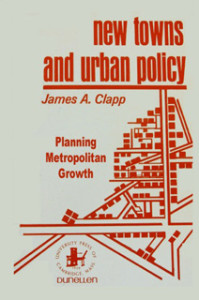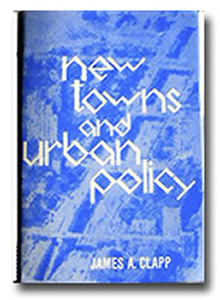
New Towns and Urban Public Policy: Planning the American Metropolis, New York: Dunellen, 1971, 337 pp.
Selected as Library of Urban Affairs main selection for December, 1971. Also selected as a Significant Social Science Book of the Month, Transaction, May l971.
Revised paperback edition October 1973.
This book was written and published before the digital revolution, but an eBook version will soon be available on Amazon.com. Meanwhile, the essay below is derived from the book and several visits to Egypt, and provides and overview of its treatment of the subject.
NEW TOWN DREAMS:
FROM THE BANKS OF THE NILE TO THE PACIFIC SHORE
James A. Clapp Ph.D.
Question: What could the planners and builders of a new town for the 21st century learn from the experience of a heretical Egyptian pharaoh from the 13th century B.C.?
Answer: Maybe some important lessons about the dreams and fates of new towns.
Although new towns are often associated with new ideas in planning, the new town idea itself is anything but novel. New towns were planned and built even before Akhenaton built his new capitol at a bend in the Nile midway between the capitols of upper and lower Egypt, Thebes and Memphis. The pharaoh was Egypt’s first monotheist. He worshipped a universal god called Aten, for whom he built his new capital, Aket-aten, the residence of the Aten. Monotheisim died in ancient Egypt with the pharaoh’s assassination, and so did his new town. Today, even its name is all but forgotten; the ruins and empty streets of his town are called Tel-el-Amarna. Like all new towns, Aketaten was planned for a pre-determined purpose and built under the control of a single authority.
New towns have been established for a wide array of purposes: The Greeks had a policy of dispatching excess residents and a planner when their existing cities became too large to found new towns. Naples, one of their towns, retains the name they gave to these settlements–“neopolis,” or newcity. Alexander the Great reputedly built sixteen Alexandrias to colonize new territories, including the one in Egypt. The Romans built even more new towns, founding them on their military camps, called “castra”. Many are still with us, including Londinium and any city whose name ends with “-chester,” the anglicized suffix for “castrum”.
In other times and nations new towns were established as capitols, to exploit natural resources, for population overflow, even to make atomic bombs. They are variously referred to as “villanovas,” “neustadts,” “nouvellevilles,” and “novgorods”. Many new towns of the past disappeared, many have been built over and bear little resemblance or relation to their original design and purposes.
However, whatever fate they have met none has proven an exception to the rule that the fates of cities, however they are conceived, planned and built, are inextricably bound up with the fates of nations, political and economic circumstances, and even religions. The allure of the new town idea may is that it offers a unique opportunity to consciously site, creatively plan and build, unfettered by the people and politics that frustrate planners in established cities. But the destiny of a new town, as that of any city, will be determined by factors beyond the control of its planners.
In 1898 an English inventor and social reformer published a small book titled “Garden Cities of Tomorrow: A Peaceful Path to Reform.” It was to become a classic in city planning literature and make its author, Ebenezer Howard, the father of the modern new towns movement. Like many reformers of his time Howard was repulsed by the slums, pollution and crushing urban densities brought on by the industrial revolution in cities. His solution was both simple and compelling: surround cities like London with a “greenbelt” and build a constellation of new towns “for healthy living and industry” just beyond. These new towns would then take up the population drawn towards London by industrialism. The new cities in gardens of countryside would be innovatively planned to marry the best features of town and country for an optimal population size (which he considered to be about 32,000).
To carry out his proposal Howard proposed public development corporations to acquire land, plan and build the towns. That may not seem too radical, but here is where Howard’s socialist leanings came into play. Howard reasoned correctly that, as a town grows, the value of its land appreciates. He felt that this increased value should belong to the entire community, not go into the bank accounts of builders and developers. In effect, the residents of the town would be shareholders in the development corporation.
Howard established corporation which built two new towns north of London in the 1920s, Letchworth and Welwyn garden cities. Meanwhile his ideas spread to other countries. In the United States two of his disciples, Henry Wright and Clarence Stein based the new town of Radburn, N.J. on Howard’s planning ideas. Unfortunately, the it opened its doors on the eve of the Great Crash of 1929 and the only portion completed stands out like an oasis in a desert of suburban monotony. Nevertheless, planners remained optimistic about the prospects for the new towns idea as a means of creatively addressing a variety of problems. In the 1930s federal New Deal planners conceived several “Greenbelt Towns” to demonstrate Howard’s ideas, but only two of these, Greenbelt, Maryland, and Greenhills, Ohio, came into being. With the scant exceptions of Norris, Tennessee, built in conjunction with the TVA, and Los Alamos, N.M., built as part of the Manhattan Project, the Greenbelt Towns were the last attempt by the Federal government to build new towns. However, during World War II new town proponents in Britain received assistance from and unlikely source–the German Luftwaffe.
The London Blitz had shown that the concentration of industry in London made an easy target. To avoid such a future vulnerability as well as to address other urban problems the British government embarked on a comprehensive program of new towns in metropolitan regions. Howard’s ideas became public policy in the New Towns Act of 1947, and the British policy became of model for subsequent policies in Scandinavia, France and other countries.
But not the United States. The exhortations of planners for an American new towns program met the staunch resistance of private real estate development interests, who saw nothing good in the prospect of government as a competitor, branding such notions as “socialism”. Instead the Federal government created mortgage guarantee programs to assist homebuyers (and builders), the National Defense Highway Act, which opened up vast suburban areas to development, and local planning assistance programs to help local governments deal with the results. The results were a abomination to new towns proponents and planners in general: urban sprawl, proliferation of local governments which foiled metropolitan planning, and an exodus of business and the middle class from central cities.
But in the 1960s, the new town idea got a boost, again from an unlikely quarter–American private development corporations discovered the new town. What in fact they discovered was that old Ebenezer Howard didn’t have such a bad notion after all; just substitute private development corporation for his public development corporation and all that appreciated land value could be theirs. The Levitt Brothers, developers of the Levittowns, and other large developers discovered that rather than just suburbs why not build entire “communities” and capitalize on the market created for commercial properties, industrial cites, perhaps even selling your homebuyers recreational and public services. Why let others cash in on the ancillary markets created by your homebuyers. Suddenly private new towns were sprouting all over America, in particular the National Capital area, Arizona, Texas, Florida, and California. New towns like Reston, Va., and Columbia, Md. were even received cover stories in national magazines.
A new day was dawning in American urban development, and the private sector was leading the way. Builders teamed up with railroad companies, oil companies and other large landholders to start more that seventy-five new towns, some projected for populations of tens of thousands. The fact that these were to be master-planned communities with state-of-the-art land planning also served as a marketing tool for buyers, who would have the security of knowing exactly where the golf courses, bridal paths, recreation centers and shopping centers would be. Planning meant security for the home buyer, who was not just buying a house, but an entire “planned community.” The new town idea had been given a distinctly American enterprise expression.
By 1966 the Federal government got into the act. Recognizing the potential of such large developments for better land planning and regional planning it created a program of up to $50 million of mortgage insurance to assist new town developers with the heavy front-end costs of land acquisition and infrastructure development. A New Communities Division was formed at HUD (“new towns” still smacked of socialism). All seemed in readiness for a public-private partnership which might finally bring better planning and development to expanding metropolitan regions.
Then the weather of this bright new day turned cloudy. It soon became evident that new towns had characteristics that made for a delicate balancing act between location, size, and financing. To acquire parcels large enough for new towns most developers had to look some distance from established urban areas. Land was cheaper in the sticks, but acquisition costs were still hefty because of the amount of land involved. The down-side of this was that developers often found themselves having to work with local governments ill-prepared to deal with new towns. Obtaining favorable zoning, infrastructural connections, and other necessities took lots of money and protracted the time between land acquisition and house sales.
All the while the interest on this enormous investment was stacking up. In the case of the renowned Reston the backers ended up taking over the project from the original developer. This is where the Federal government’s largesse was intended to help. However, most developers were daunted by Federal requirements, for consistency with local planning and zoning, innovative planning, “social balance,” and other factors which protracted the process might cause sales, hence profits, to be slower. Moreover, developers were finding that bold new planning ideas might look good, but homebuyers often saw them as a risk for the largest personal investment. It became hard to distinguish many new towns from conventional suburban development. There were some hard realities to countervail the high hopes for new towns.
The recession of the early 1970s, the oil crises, rising interest rates and other economic miseries finally burst the bubble. Some new towns managed to carry on, but others scaled back, sold land to cover debts, or collapsed altogether. The Federal government ended up the receiver of several of the projects it underwrote. Mounting public service costs of local governments, coupled with tax revolts, and growth management movements added to developers’ woes. Local governments became wary of large-scale developments that might require new connecting roads, trunk sewers, and other public service costs. An added threat was that even new town residents themselves might catch the home rule virus themselves and take governmental matters into their own hands by incorporating, thereby compromising the developer’s control over future development of the town.
New towns in California appear to have fared better than most under these circumstances, largely because of high housing demand, many local governments giving only lip service to growth management, and an employment mix that is more recession proof than Texas and Arizona. But the economic clouds on the horizon may offset or change some of these advantages.
Though these same clouds may usher in another period in which the new towns are more of a utopian concept than a physical reality the dream of planning and building urban communities which improve the quality of urban life will doubtless remain a recurrent and resilient one. It will remain the belief of planners and city builders that, given the opportunity to begin anew, the ideal city might be realized. Yet, doubtless, history will show again that the winds of change can carry unforeseen destinies for the best laid plans of pharaohs and developers.?

